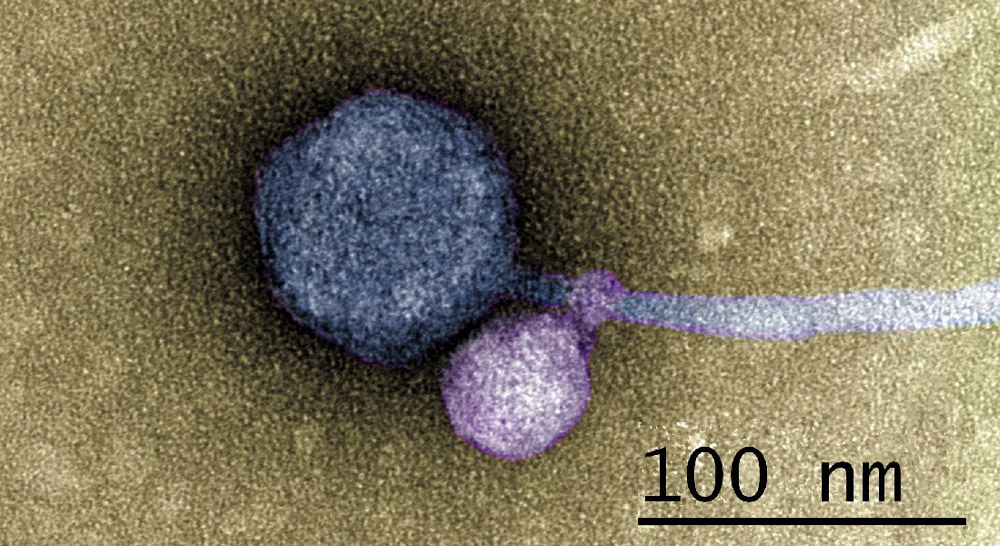November 8, 2023 Reading time: 4 minutes.
Illustrated evidence: A research team has observed for the first time how two different viruses bind to each other and combine. Until now, this form of communication between different viruses was not known. As genetic analyzes have shown, these phages help each other infect the host cell and reproduce. This is the first evidence of this type of relationship between viruses, according to the team. However, the reaction mechanism could be more widespread than thought.
As is known, viruses need a host organism in order to reproduce. This could be, for example, a human cell, or bacteria in the case of phages. “Some viruses, called satellites, also depend on another virus, the ‘helper,’ to complete their life cycle,” explains senior author Evan Irel of the University of Maryland. Therefore, the dependent virus needs the helper either to build its protective envelope, which surrounds the virus’s genetic material, or to help it replicate its DNA.
For this to happen, the satellite virus and the helper virus must be at least temporarily close to each other. However, there is still no known evidence of a satellite actually attaching itself to an assistant.
The first picture of connecting the satellite assistant
A research team led by Tajide de Carvalho from the University of Maryland has now been able to capture detailed images of satellite auxiliary contacts for the first time. To do this, the researchers used transmission electron microscopy (TEM) to observe samples of phages that infect bacteria from the genus Streptomyces and whose genetic analyzes had previously revealed inconsistencies.
The images showed that 40 of the 50 helper viruses were not present individually, but were associated with a satellite virus. “When I saw it, I couldn’t believe it,” De Carvalho says. “No one has ever seen phages or any other virus attach to another virus before.”
As the team observed, the satellite phages attached their “tail” to the “neck” of the helper phages — the piece that connects the “head” containing the genetic material to the tail of the virus. In some individual helper viruses, there were also remnants of satellite tail proteins on the neck, which the researchers described as “bite marks.” It is also striking that the satellite viruses never associated directly with the host bacterial cell in the images, but only indirectly via the helper virus.
What are the uses of Dual Virus Pack?
But what purpose does this virus pairing serve? To learn more about viral interaction, scientists have sequenced the genomes of dependent viruses, helper viruses, and host cells. They found genes in viruses for their protective envelopes, but not for their reproduction. It is appropriate that these dependent viruses depend on the cellular machinery of their bacterial hosts to reproduce.
For this to work, their viruses must insert their own genetic material into the bacterial cell material. This is usually ensured by a special gene in the virus, which is also present in already known dependent viruses and in some recently examined satellites, which do not require direct contact with their helper viruses. However, the satellite can only replicate if a helper virus enters the host cell and brings with it additional genetic information.
Help for joint infections
However, the situation appears to be different with the now-discovered satellite viruses associated with their helpers. As De Carvalho and her colleagues discovered, these satellites, called “MiniFlayers,” lack an integrative gene to insert their genetic material into the host gene. This is why these dependent viruses are absolutely dependent on the simultaneous presence of helper viruses in the host – without their genetic help, they cannot infiltrate the host genome.
“The correlation now makes perfect sense,” says Erel, “because how can the viruses ensure they get into the cell at the same time?” This fits with the researchers’ observation that these MiniFlayer satellite viruses contain specialized tail components composed of fibrous proteins. , through which they can bind to helper phages. The researchers explain that this can ensure co-infection through simultaneous entry into the host. However, direct evidence for this explanation is still missing.
Widespread phenomenon?
Researchers have also used bioinformatics methods to study the evolutionary development of these viruses. The analyzes revealed that MiniFlayer satellite viruses and their helper viruses co-evolved for a long time. “This satellite has been fine-tuning for at least 100 million years and has optimized its genome so that it binds to the helper,” Erel says. This suggests that there may be many cases of this type of relationship between viruses.
“It is likely that many of the bacteriophage samples that were thought to be contaminated were actually satellite helper systems,” De Carvalho says. Their analyzes also began with an analysis of the bacteria’s contaminant genetics, which the researchers then identified. Future work could study in more detail how common this phenomenon is and how the satellite communicates with the assistant. (ISME Journal, 2023; doi: 10.1038/s41396-023-01548-0)
Source: University of Maryland
November 8, 2023 – Claudia Crabb

“Total coffee aficionado. Travel buff. Music ninja. Bacon nerd. Beeraholic.”








More Stories
Coral Seeding: Artificial Insemination Makes Coral More Heat Tolerant
Fear, Anger, and Denial: How People Respond to Climate Change – Research
LKH Graz: Using radiation to combat heart arrhythmias